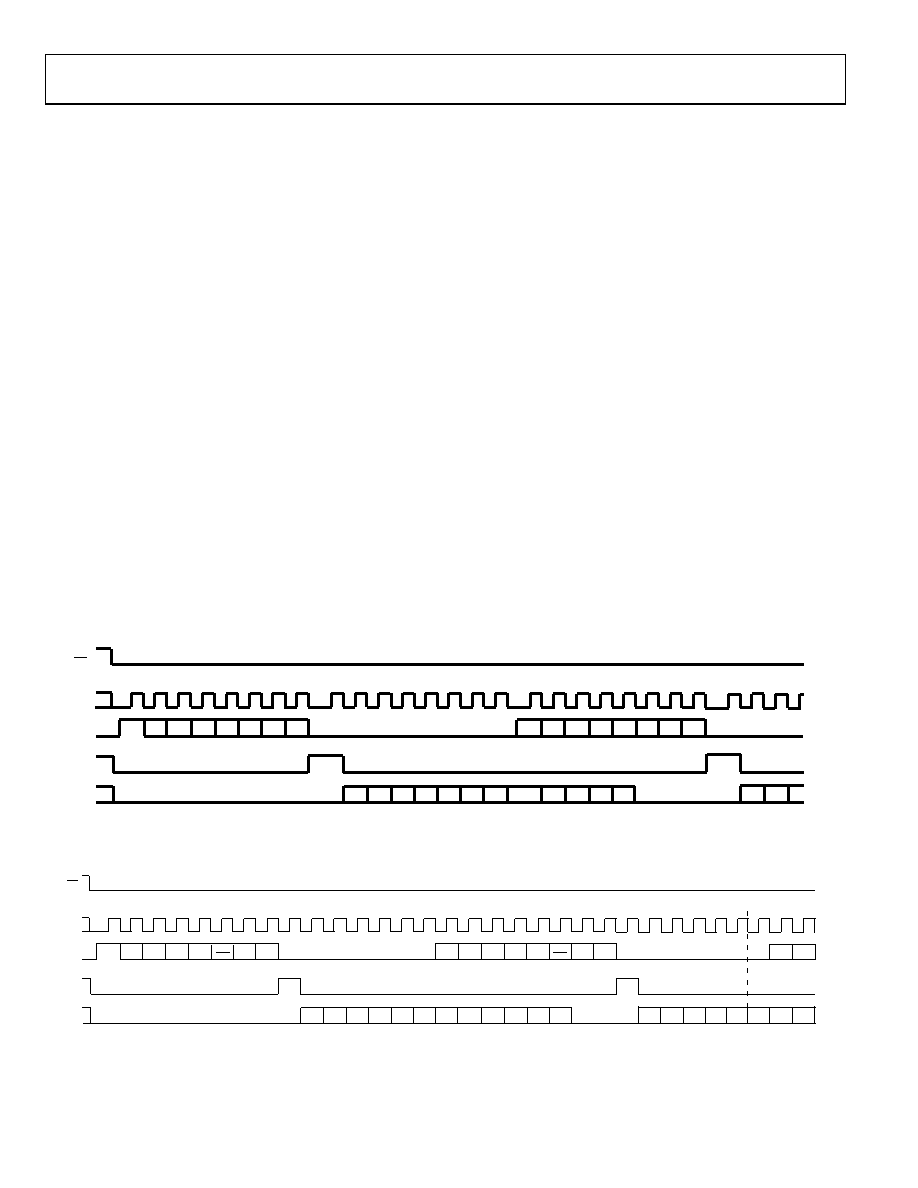- 您現(xiàn)在的位置:買賣IC網(wǎng) > PDF目錄17036 > EVAL-AD7843EBZ (Analog Devices Inc)BOARD EVAL FOR AD7843 PDF資料下載
參數(shù)資料
| 型號: | EVAL-AD7843EBZ |
| 廠商: | Analog Devices Inc |
| 文件頁數(shù): | 11/21頁 |
| 文件大小: | 0K |
| 描述: | BOARD EVAL FOR AD7843 |
| 標準包裝: | 1 |
| ADC 的數(shù)量: | 1 |
| 位數(shù): | 12 |
| 采樣率(每秒): | 125k |
| 數(shù)據(jù)接口: | 串行 |
| 輸入范圍: | 0 ~ 5.25 V |
| 在以下條件下的電源(標準): | 1.4mW @ 125kSPS |
| 工作溫度: | -40°C ~ 85°C |
| 已用 IC / 零件: | AD7843 |
| 已供物品: | 板 |
| 相關產(chǎn)品: | AD7843ARUZ-ND - IC ADC 12BIT TOUCHSCREEN 16TSSOP AD7843ARUZ-REEL7-ND - IC ADC 12BIT TOUCHSCREEN 16TSSOP AD7843ARQZ-ND - IC ADC 12BIT TOUCHSCREEN 16-QSOP AD7843ARQZ-REEL7-ND - IC ADC 12BIT TOUCHSCREEN 16-QSOP AD7843ARQZ-REEL-ND - IC ADC 12BIT TOUCHSCREEN 16-QSOP |

AD7843
Rev. B | Page 18 of 20
Sixteen Clocks per Cycle
The control bits for the next conversion can be overlapped with
the current conversion to allow for a conversion every 16 DCLK
cycles, as shown in Figure 26. This timing diagram also allows
for the possibility of communication with other serial peripherals
between each (eight DCLK) byte transfer between the processor
and the converter. However, the conversion must be completed
within a short enough time frame to avoid capacitive droop
effects that could distort the conversion result. It should also be
noted that the AD7843 is fully powered while other serial
communications are taking place between byte transfers.
Fifteen Clocks per Cycle
Figure 27 shows the fastest way to clock the AD7843. This
scheme does not work with most microcontrollers or DSPs
because, in general, they are not capable of generating a
15-clock-cycle-per-serial transfer. However, some DSPs allow
the number of clocks per cycle to be programmed; this method
could also be used with FPGAs (field programmable gate
arrays) or ASICs (application specific integrated circuits). As in
the 16-clocks-per-cycle case, the control bits for the next
conversion are overlapped with the current conversion to allow
a conversion every 15 DCLK cycles, using 12 DCLKs to
perform the conversion and three DCLKs to acquire the analog
input. This effectively increases the throughput rate of the
AD7843 beyond that used for the specifications that are tested
using 16 DCLKs per cycle, and DCLK = 2 MHz.
8-Bit Conversion
By setting the MODE bit to 1 in the control register, the
AD7843 can operate in 8-bit rather than 12-bit mode. This
mode allows a faster throughput rate to be achieved, assuming
8-bit resolution is sufficient. When using the 8-bit mode, a
conversion is complete four clock cycles earlier than in the
12-bit mode. This could be used with serial interfaces that
provide 12 clock transfers, or two conversions could be
completed with three 8-clock transfers. The throughput rate
increases by 25% as a result of the shorter conversion cycle, but
the conversion itself can occur at a faster clock rate because the
internal settling time of the AD7843 is not as critical because
settling to 8 bits is all that is required. The clock rate can be as
much as 50% faster. The faster clock rate and fewer clock cycles
combine to provide double the conversion rate.
02144-B
-026
CS
DCLK
DIN
BUSY
DOUT
1
S
11
10
9
8
7
6
5
4
3
2
1
0
11
10
9
11
1
88
8
CONTROL BITS
Figure 26. Conversion Timing, 16 DCLKS per Cycle, 8-Bit Bus Interface. No DCLK delay required with dedicated serial port.
02144-
B-
027
CS
DCLK
DIN
BUSY
DOUT
S
A2
PD1 PD0
A1
A0 MODE
SER/
DFR
MODE
SER/
DFR
1
11
10
9
8
7
6
5
4
3
2
1
0
11
10
9
8
7
6
5
4
15
1
15
1
SA2
A1
PD1 PD0
A0
Figure 27. Conversion Timing, 15 DCLKS per Cycle, Maximum Throughput Rate
相關PDF資料 |
PDF描述 |
|---|---|
| GEC40DRYH-S13 | CONN EDGECARD 80POS .100 EXTEND |
| EVAL-AD7607EDZ | EVAL BOARD FOR AD7607 |
| GSC12DRTS-S13 | CONN EDGECARD 24POS .100 EXTEND |
| GMC12DRTS-S13 | CONN EDGECARD 24POS .100 EXTEND |
| 0210490306 | CABLE JUMPER 1.25MM .102M 24POS |
相關代理商/技術參數(shù) |
參數(shù)描述 |
|---|---|
| EVAL-AD7851CB | 制造商:Analog Devices 功能描述:14-BIT 333 KSPS SERIAL A/D CONVERTER 制造商:Analog Devices 功能描述:EVALUATION CONTROL BOARD I.C. - Bulk |
| EVAL-AD7851CB4 | 制造商:AD 制造商全稱:Analog Devices 功能描述:14-Bit 333 kSPS Serial A/D Converter |
| EVAL-AD7853CB | 制造商:Analog Devices 功能描述:EVALUATION CONTROL BOARD - Bulk |
| EVAL-AD7854CB | 制造商:Analog Devices 功能描述:EVALUATION CONTROL BOARD - Bulk |
| EVAL-AD7856CB | 制造商:AD 制造商全稱:Analog Devices 功能描述:5 V Single Supply, 8-Channel 14-Bit 285 kSPS Sampling ADC |
發(fā)布緊急采購,3分鐘左右您將得到回復。